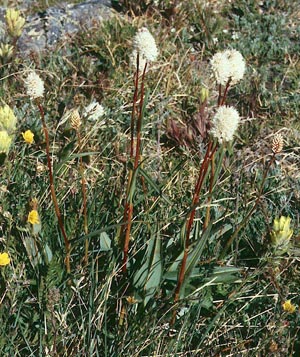American Bistort

Common Name(s):
American Bistort
Scientific Name:
Polygonum bistortoides Pursh
Scientific Name Synonyms:
Bistorta bistortoides (Pursh) Small
Persicaria bistortoides (Pursh) H. Hinds
Polygonum cephalophorum Greene
Polygonum glastifolium Greene
Polygonum vulcanicum Green
Symbol:
POBI6
Description:
Life Span: Perennial
Origin: Native
Season: season goes here
Growth Characteristics: American bistort grows from a short rhizome with 1 to several erect flowering stems, growing 10 to 28 inches tall. It has a woody twisted rootstock, often with a swollen cormlike crown. Flowers appear mostly in July and August.
Flowers: Dense white or pale pink flowers clusters at the top of slender stems. Flowers are in spike-like terminal racemes with many flowers. The spike is 1 ½ - 2 inches long and ½ - 1 inch wide. The perianth is long, divided most of its length into 5 oblong, equal, white to pink segments. There are 8 stamens on long filaments which protrude from the flower.
Fruits/Seeds: Achene with three sharp angles, yellowish-brown, smooth and shining, about 1/8 inch long.
Leaves: Mostly basal, with long petioles. The blade is elliptic to lance shaped. Leaves have brownish stipules, 3-6 cm long. There are few small stem leaves that are sessile with a somewhat heart-shaped base.
Stems: Slender, erect, reddish stems, which do not branch.
Roots: Rhizomes
Ecological Adaptions:
American bistort is one of the most common species found in mountain meadows throughout the West. Its most common habitats are wet meadows, swamps, around seeps, in moist openings in the timber and in high, moist mountain parks. It is found at elevations from 2,000 feet to 13,000 feet. In many localities it grows only as scattered individuals and does not make up an appreciable part of the plant cover, but in some restricted meadow and park areas it occurs in great abundance, occasionally being one of the dominant plants.
Soils: Moist
Associated Species: Marshmarigold, Alpine speedwell, sedges.
Uses and Management:
American bistort is eaten by both livestock and wildlife. The palatability varies in different localities, being regarded as worthless in some areas, and highly used in others.
Roots were used in soups and stews by the Blackfoot, boiled with meat by the Cherokee, and used in a poultice that was applied to sores and boils by the Miwok.

